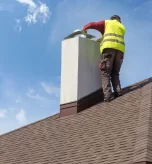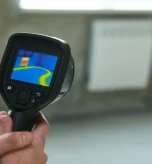When was the last time you had your chimney inspected? Regardless of how often you use your fireplace, regular chimney inspections are necessary. This helps keep your home safe and energy-efficient.
This guide will help you understand what to know before your next chimney inspection. It covers key terms, inspection levels, what professionals inspect, and the associated costs.
Why Chimney Inspections Matter?
People often overlook chimneys until something goes wrong, like poor ventilation, smoke backup, or even chimney fires. Regular chimney inspections help detect early signs of damage, creosote buildup, or structural weaknesses. Certified chimney inspections make sure your system meets local safety codes. They can also help you avoid expensive repairs later.
Read More: What to Expect During an HVAC System Inspection?
Common Types of Chimney Inspections
There are three primary levels of chimney inspections, each serving a different purpose.
Level 1 Chimney Inspection
This is the most basic type, and experts recommend it if your chimney and appliance have not undergone any changes and are in regular use. It involves a visual check of the accessible parts of the chimney, including the firebox, flue, and chimney cap.
Level 2 Chimney Inspection
Required when there’s been a change, like a new heating appliance or recent property sale. This level includes all features from Level 1. It also has an internal inspection with chimney cameras. You will have access to the attic, basement, and crawlspaces. It’s also the standard after a chimney fire or natural disaster.
Level 3 Chimney Inspection
This is the most thorough inspection and includes the removal of certain building materials. You only need it when you suspect serious hazards.
Key Components Inspected
Professional chimney inspection services usually cover the following areas:
- Chimney Cap Inspection: Ensures the cap is intact, preventing water or animals from entering.
- Chimney Flue Inspection: Checks for blockages, cracks, and creosote buildup.
- Fireplace and Chimney Inspection: Examines the fireplace structure, damper, and interior walls.
- Structural Assessment: Reviews brickwork, mortar joints, and the crown.
- Ventilation and Draft: Ensures smoke is venting correctly to prevent carbon monoxide buildup.
What About Chimney Cleaning and Inspection?
Often combined, chimney cleaning and inspection services clean out soot and creosote while simultaneously checking for safety issues. Chimney sweep and inspection costs can vary depending on the region and the chimney’s condition.
Cleaning is essential if you notice smoke backup or strange odours. Scheduling annual chimney inspections and cleanings is a good rule of thumb.
How Much Does a Chimney Inspection Cost?
The price of a chimney inspection depends on several factors, including location, chimney type, and the level of inspection.
| Inspection Type | Typical Cost Range (USD) |
| Level 1 Inspection | $75 – $200 |
| Level 2 Inspection | $150 – $500 |
| Level 3 Inspection | $500 – $1000+ |
If you require additional services, such as chimney cleaning or chimney cap replacement, you can add those costs separately.
In areas like Fort Worth, prices may vary slightly depending on local rates and the type of chimney inspection company.
Certified vs. Non-Certified Inspections
Always choose certified chimney inspections performed by trained professionals. Certification ensures the inspector understands local codes and safety standards. A crucial detail exists when choosing between chimney inspection services.
Chimney Inspection for Gas Fireplaces
Even if you have a gas fireplace, inspections are still necessary. A certified chimney inspector will check for the following:
- Proper ventilation
- Gas line integrity
- Flue obstructions or damage
- Carbon monoxide leaks
Skipping inspections for gas fireplaces can lead to hidden dangers, even in the absence of traditional soot buildup.
Chimney Inspection Cameras: How They Help
Modern chimney inspection companies utilise cameras to identify issues deep within the flue. These allow for detailed views of cracks, blockages, or deterioration without the need to dismantle parts of your home. Especially valuable during Level 2 chimney inspections.
Red Flags That Signal an Immediate Inspection
If you notice any of the following, schedule a certified inspection immediately:
- Smoke entering your living space
- Unusual odours when using the fireplace
- White staining on the chimney exterior (efflorescence)
- Loose bricks or crumbling mortar
- Rusted firebox or damper
Delaying an inspection in these cases could increase chimney inspection and cleaning costs because of extensive damage.
Read More: Top Reasons Home Inspections Fail and How to Fix Them?
DIY: Can You Inspect Your Own Chimney?
Homeowners can do a simple visual check. However, a thorough inspection, especially of the chimney flue, requires professional tools and expertise. Also risky, especially on steep rooftops. For safety and reliability, it’s best to rely on professional chimney inspection services.
How Often Should You Clean and Inspect a Chimney?
The National Fire Protection Association recommends annual chimney inspections. Chimney cleaning and inspection might be needed more frequently if:
- You burn wood often
- Your fireplace is your primary heat source
- You notice performance issues
FAQs
1. How much does a chimney inspection cost?
The cost depends on the level of inspection needed. A basic Level 1 inspection typically ranges from $75 to $200 and is suitable for routine maintenance. A Level 2 inspection, which involves video scanning and attic access, costs between $150 and $500. Level 3 inspections are more intrusive and can exceed $1000. Please note that additional services, such as cleaning or repairs, will increase the total cost.
2. Do I need a chimney inspection if I don’t use my fireplace often?
Yes. Even if you don’t use your fireplace often, the weather can still harm your chimney. Rain, snow, and temperature changes can cause damage. Animals can also nest in unused chimneys, and the buildup of moisture can weaken the structure. An annual inspection ensures your system remains safe and that minor issues are identified before they become costly problems.
3. What is a Level 2 chimney inspection?
A Level 2 chimney inspection is a more comprehensive evaluation than a basic Level 1. It includes a visual check of accessible areas and a video inspection using a specialised camera. You need this level if you’ve had a chimney fire, changed appliances, or recently bought or sold the home. It also includes inspection of crawlspaces, attic spaces, and basements to ensure no structural issues exist beyond the floor.
4. Is cleaning included in the inspection?
Not always. Some chimney inspection services offer combined packages, but they typically charge separately for cleaning. If there is creosote or soot buildup during the inspection, your provider might recommend cleaning. This should be done before you use the fireplace again. It’s always a good idea to clarify with your inspector whether cleaning is included in the quoted service.
5. How do I know if I need a chimney cap inspection?
Check your chimney cap if you notice moisture in your fireplace. Other signs include animal droppings, debris buildup, or rust near the damper. A damaged or missing cap can allow water and pests to enter, leading to structural issues or blockages. Regular inspections help maintain your chimney cap and prevent larger problems down the line.
Final Thoughts
Before your next chimney inspection, knowing what to expect can help you ask the right questions and avoid surprises. Knowing the difference between inspection levels is important. It is helpful to understand what cleaning and inspections entail. Additionally, being aware of the general cost of chimney inspections enables you to make more informed choices.
If you live in Riverside, California, or the surrounding area, always hire a certified professional. They can clean and inspect your chimney. This helps keep your home safe, efficient, and strong.
For trusted inspections in your area, visit Key Property Inspection Group and schedule your certified chimney inspection today.
Are You Looking for Reliable Inspection Services?
We offer professional property inspection services throughout Riverside, California, and its surrounding areas. Whether you’re buying, selling, or maintaining a property, our expert team is here to help. We proudly serve clients in the following locations:
| Agoura Hills | Alhambra | Arcadia | Artesia | Avalon | San Marino |
| Azusa | Baldwin Park | Bell | Bellflower | Bell Gardens | Signal Hill |
| Beverly Hills | Bradbury | Burbank | Calabasas | Carson | Torrance |
| Cerritos | City of Industry | Claremont | Commerce | Compton | Santa Clarita |
| Covina | Culver City | Diamond Bar | Downey | Duarte | South El Monte |
| El Monte | El Segundo | Gardena | Glendale | Glendora | Vernon |
| Hawaiian Gardens | Hawthorne | Hermosa Beach | Hidden Hills | Huntington Park | Santa Fe Springs |
| Inglewood | Irwindale | La Cañada Flintridge | La Habra Heights | Lakewood | South Gate |
| La Mirada | Lancaster | La Puente | La Verne | Lawndale | Walnut |
| Lomita | Long Beach | Los Angeles | Lynwood | Malibu | Santa Monica |
| Manhattan Beach | Maywood | Monrovia | Montebello | Monterey Park | South Pasadena |
| Norwalk | Palmdale | Palos Verdes Estates | Paramount | Pasadena | West Covina |
| Pico Rivera | Pomona | Rancho Palos Verdes | Redondo Beach | Rolling Hills | Sierra Madre |
| Rolling Hills Estates | Rosemead | San Dimas | San Fernando | San Gabriel | Temple City |
Regardless of your location within these areas, our inspection experts are ready to assist you. Contact us today to schedule your inspection.





